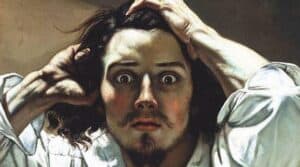The painter Gustave Courbet who was the central figure of Realism, is known for his paintings in which he reveals the true lives of peasants and ordinary workers, at a time when the most well-accepted portraits were those with mythological heroes or religious scenes.
Yet, while portraying what he saw with intense realism, politically speaking Courbet was an idealist and a visionary.
One of his most important political activities has to do with the Paris Commune.
In this post by Rute Ferreira get to know this artist who broke the rules of his time..
Cover image – Gustave Courbet – The desperate man, 1877.

Gustave Courbet
Gustave Courbet was born in France in 1819.
He began to study art very early, and from the late 1840s he became a respected and admired artist.
His art was a challenge since his conservative society didn’t want to see portraits of ordinary people. But it didn’t matter to him. His plan was just one: to paint only what he saw, to record what was in front of him.

The political situation in France
During the more intense period of Courbet’s production, France’s political situation was not too calm either.
 In 1870, under the command of Napoleon III (nephew of Napoleon Bonaparte), France went to war against Prussia. The Prussian kingdom then allied itself with the other German states and invaded France, which faced several defeats, until Napoleon surrendered.
In 1870, under the command of Napoleon III (nephew of Napoleon Bonaparte), France went to war against Prussia. The Prussian kingdom then allied itself with the other German states and invaded France, which faced several defeats, until Napoleon surrendered.
A Republican government was set up that same year. Extremely conservative, the seat of this government moved from Paris to Versailles.
The fruit of this was the Paris Commune, a social movement that demanded the reform of the economy, based on a form of government that was, as the name suggests, communal.
But what does Courbet have to do with all this?
From the beginning of the reign of Napoleon III, in 1851, Courbet already was considered an artist who transgressed the norms.
His painting was considered an affront, for he not only used ordinary people as a theme, but also portrayed the elite’s flaws, its corruption, and its distorted morality.
With the defeat of the emperor, Courbet played a significant role in the political life of Paris. In 1871, he wrote in a letter to the family:
I am, thanks to the people of Paris, with politics up to my neck […] Paris is a true paradise! No police, no nonsense, no charges of any kind, no matter what, everything in Paris works like clockwork, oh, if it could stay like this forever.
He had many roles as a member of the Commune, he was a representative of the city hall and a representative of the Ministry of Public Education. Courbet said that Paris was a “beautiful dream”.
 The Wheat Sifters, 1855
The Wheat Sifters, 1855
3 Comments.
Tyvm for the helpful post! I would not have gotten this myself!
Glorious read, I just passed this onto a colleague who was doing a little analysis on that. And he actually purchased me lunch because I found it for him smile So let me rephrase that: Thanks for lunch! Anyway, in my language, there usually are not much good source like this.
Spot on with this write-up, I actually assume this website needs rather more consideration. I’ll most likely be again to learn rather more, thanks for that info.